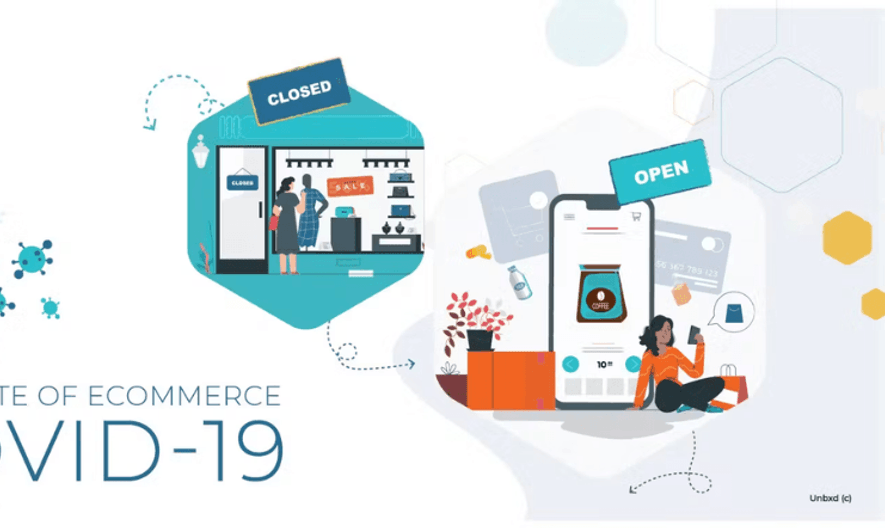- ProductsSearch and BrowseRecommendations
- Solutions
- Integrations


Social Distancing. Lockdown. Work From Home. Non-Essential Businesses Shut. No public gathering – the world went to a complete halt almost as soon as COVID-19 took over the world in its grip. Let’s admit, we didn’t see that coming!
Over the last couple of weeks, COVID-19 has forced many retailers and brick-and-mortar stores to shut down and go non-operational. In more and more cities (and today, as you read this piece), almost the entire world is encouraging citizens to stay indoors. This has spurred a drastic shift in how you and I buy stuff. It has changed how we buy and what and when we are buying. The virus got all of us to reassess our priorities and buying trends.
We started seeing a spike in overall ecommerce activity starting 1st Week of March. Not did we know then that what was a regional emergency in China would take the form of a global pandemic and worldwide shutdown. This caused a surge in online shopping and bulk buying across the globe.
Unbxd powers ecommerce Search and product discovery across verticals for more than 1300 ecommerce sites in 40+ countries worldwide. Over the last few weeks, we closely monitored how ecommerce started to react to this worldwide pandemic and how it will shape itself in the times to come. The data and insights below might as well be useful in re-assessing your business priorities and being prepared for the future.
Overall ecommerce
We compared the data from the same time in the previous year, 2019, to March 2020, and week-on-week ecommerce activity. The charts below illustrate how the following metrics saw an increase:
-
Site Traffic
-
Search Traffic
-
Transactions
-
Conversion

We can clearly see that consumers across the globe resort to online searching and buying to address their needs. Search traffic went up by approximately 3%, and transactions went up by 3.3% starting the 2nd week of March compared to the 2nd week of February. Such fast was the reaction of the end-consumers to their shopping needs.

If you have a look at the Y-o-Y data, it is startling to see that for a 6.4 % increase in search sessions, transactions went up by 11.7%. Clearly, the on-site traffic and searches are being made with higher intent and likelihood of purchase.
Ecommerce by Geography
We furthered our analysis by splitting the ecommerce activity by geography.

Clearly, the APAC and ANZ regions saw a huge spike in the number of online transactions due to being affected by COVID-19 first. This also reflects end-consumers pre-empting the lockdown and shutdown and resorting to stocking stuff and essentials at their homes.
ANZ observed a 13.88% uptick in online traffic, a 26.42% surge in search sessions, and a 51.08% increase in online transactions for the corresponding searches. Similar trends imply that the likelihood of a purchase per search session is extremely high during such times of pandemic and crisis.
With a 4.14% surge in search traffic and a 38.66% spike in transactions, we observed similar trends in APAC as in ANZ. However, on the contrary, we saw a dip in the overall online traffic for APAC. US ecommerce traffic, on the contrary, didn’t see similar levels of spikes in either of the parameters. Site traffic increased by 3.06%, search traffic by 0.57%, and online transactions by 1.61%. Read for more ecommerce trends in the US.
Ecommerce by Verticals

Fashion and Apparel have taken a big hit, with overall site traffic seeing a dip of 8.25%, search traffic down by 7.7%, and online transactions down by 11.04%. However, this also might indicate that when things are back to normal, end-consumers will binge-shop on these sites as a part of retail therapy to overcome what the world has witnessed.
As expected, Food and Grocery (under essential services) saw an increase of 55.19% in the site traffic, a whopping 188.7% increase in the search traffic, and a 304.94% increase in online transactions for the corresponding searches. This directly reflects how end-consumers resorted to online stocking of food and other essentials as soon as the lockdowns and shutdowns were announced.
Surprisingly, B2B saw an increase across parameters – in site traffic by 41.25%, search traffic by 38.51%, and transactions by 38.68%. This behavior can result from future shockproofing to maintain the stock supply in case of snipping off the supply chain across the globe in times to come.
Lastly, we saw a similar pattern in the Mass Merchants (as that of B2B) attributed to the same reasons – the fear of not maintaining enough stock when the markets open and return to normal. It saw a 14.91% surge in site traffic, a 4.87% increase in search traffic, and an uptick of 13.79% in online transactions Y-o-Y.
Conclusion
Clearly, the end-consumers' first reaction during COVID-19 (or for that matter any crisis time like these in the future, God forbid) is to leverage the online channels for buying and stocking up stuff. The essentials and consumables will be the first to observe this change in online shopping behavior. Sectors heavily dependent on the supply chain and on other geographies might as well see a surge in their online business about future shock-proofing. Luxury, Fashion, Apparel, and other non-essential would take a back seat in times of crisis. However, this leaves this sector with scope to prepare for the times when things get back to normal.
During these times of crisis, most of the world resorts to online channels for surfing, buying, and making decisions, with a higher intent or likelihood of purchase. We could infer that from the high transactions per search being made. Under such circumstances and to future-proof your business, it will be essential that businesses and enterprises are prepared to provide a seamless on-site shopping experience to the end consumers and shoppers.
Wishing for the world to heal and a speedy recovery from the world epidemic!